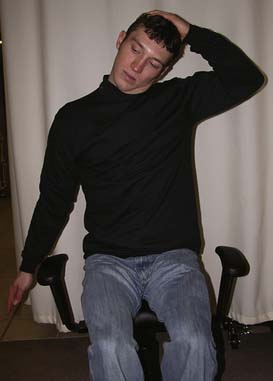49 Therapeutic Exercises
Therapeutic exercises or exercise therapy is a major component in the management of various disorders. It can be defined as any prescribed and supervised exercise program, in which, during therapy sessions, the patients are required to carry out repeated voluntary dynamic movements or static muscle contractions, either whole body or region specific and either with or without external loading with the aim of relieving symptoms or improving function, by controlling inflammation, when present, restoring range of motion (ROM), restoring and/or improving muscular strength, power and endurance, and training to return to daily and recreational activities.1–4
Convened in 1999, the Philadelphia Panel, composed of clinical experts in the fields of medicine, research, and physical therapy set out to provide a structured and rigorous set of evidence-based guidelines for the conservative (nonsurgical) management of conditions associated with low back, knee, neck, or shoulder pain. A five-step process was established to put together these guidelines: defining rehabilitation interventions most frequently used in the care of low back, knee, neck, and shoulder pain, collecting the evidence, synthesizing the results, making recommendations based on the research, and grading the strength of the recommendations.5
The panel gathered evidence from randomized clinical trials and observational studies; the data were synthesized, and the relative clinical benefit between treatment and control groups was calculated for each condition for each intervention. The studies were also graded according to type and clinical importance of the findings. The grading scheme is summarized in Table 49-1. The panel deemed a 15% or greater improvement between treatment and control groups to be clinically important. In addition, the panel circulated feedback survey questionnaires to healthcare practitioners to verify their applicability and ease of use in clinical settings. Interventions with a grade of A or B were to be included in the guidelines.5
Table 49-1 Details of the Philadelphia Panel Classification System
| Grade | Clinical Importance | Study design type |
|---|---|---|
| A | 15% | RCT (single or meta-analysis) |
| B | 15% | CCT or observational study (single or meta-analysis) |
| C | 15% | RCT or CCT or observational (single or meta-analysis) |
| ID | NA | Insufficient or no data |
CCT, controlled clinical trial; NA, not applicable; RCT, randomized, controlled trial
From Harris GR, Susman JL: Managing musculoskeletal complaints with rehabilitation therapy: Summary of the Philadelphia Panel evidence-based clinical practice guidelines on musculoskeletal rehabilitation interventions. J Family Pract 51:1-7, 2002.
Briefly, the panel gave Grade A recommendation on the efficacy of therapeutic exercises, including stretching, strengthening, and mobility exercises for the treatment of subacute, chronic, postsurgery back pain, osteoarthritis of the knee, and chronic neck pain. Grade A recommendation means the intervention resulted in clinically significant improvement in pain and function. However, there are insufficient data on the benefit of therapeutic exercises for shoulder pain.5
These recommendations were made based on the available evidence at the time. The Philadelphia Panel also noted in its recommendation, many problems with the body of evidence in the medical literature—the main concern being the lack of standardization of outcome measurements used in different studies. Also noted was the inherent difficulty of studying rehabilitation interventions, where effectiveness could be compromised by psychosocial, physical, and occupational factors, as well as improbability of blinding either the therapist or the patient to the interventions.5
To address these issues, the panel recommends that future studies develop standards of measurement that are valid, reliable, and sensitive to changes in outcome; further, studies must specifically clarify the type and manner of intervention, intervention intensity and duration, and progression of the intervention according to patient-specific outcomes. Studies need to fully randomize large patient groups to minimize selection bias. Overall, the panel stressed the need for further large studies on rehabilitation interventions with the increased use of therapeutic exercises and other physical therapy interventions for the management of low back pain, knee pain, neck pain, and shoulder pain.5
Smidt and colleagues1 summarized and assessed available evidence on the effectiveness of exercise therapy for patients with disorders of the musculoskeletal and other systems. In their assessment of 98 reviews, they concluded that exercise therapy is effective for a wide range of chronic disorders. In particular, they found exercise therapy is effective for patients with knee osteoarthritis, subacute and chronic low back pain, cystic fibrosis, chronic obstructive pulmonary disease (COPD), and intermittent claudication. They also found indications that exercise therapy is effective for patients with ankylosing spondylitis, hip osteoarthritis, and Parkinson disease, and also for patients who have had stroke. They could not find sufficient evidence to support or refute effectiveness of therapeutic exercises for patients with neck pain, shoulder pain, repetition strain injury (RSI), rheumatoid arthritis, asthma, and bronchiectasis.
However, there is insufficient evidence to support or refute the effectiveness of specific types of therapeutic exercises for all disorders, and there is little or no research on how short-term effectiveness of the exercise therapies can be maintained long term. Conversely, they found no evidence that exercise therapy is harmful or that it provoked harmful side effects. They suggested that is could be due to the inadequate reporting of side effects in randomized controlled trials.1
In 2007, Taylor and colleagues,2 whose review included results from the Philadelphia Panel, Smidt and colleagues and 36 other studies found strong evidence that therapeutic exercises can benefit people across broad areas of physical therapy practice.2
Reviews published in the years of 2002 to 2005 that were assessed by Taylor and colleagues2 showed that exercise interventions that led to significant improvements were varied and diverse, but all the effective exercise programs tended to be intense. These results were found in people with musculoskeletal disorders (e.g., people with chronic back pain and people who have had lumbar disc surgery). Similarly, people with multiple sclerosis, coronary heart disease, and COPD, who participated in programs four to five times a week at relatively high intensity, showed significant improvements in their muscle strength and mobility for those with multiple sclerosis and for patients with heart disease or COPD, improved exercise capacity and less shortness of breath. There was no evidence that exercise of relative intensity caused exacerbation of symptoms such as increased fatigue in patients with multiple sclerosis, or disc reherniation in patients who have had lumbar disc surgery.2
Another common theme that emerged was that results were more favorable when therapeutic exercise was compared to a no treatment control group. However, like Smidt and colleagues, Taylor and coworkers did not find sufficient evidence that one type of exercise was superior to another. This finding was common in many areas of practice.1,2
However, Taylor and colleagues noted that a particularly useful finding for clinical practitioners, was that therapeutic exercise may be more effective when it is individualized or targeted. Studies showed that individualized exercises were more effective than standardized exercise programs wherein every patient is given the same regimen.2 Effective individualized exercise programs begin with sequential steps to help identify the needs of the patient—assess the patient, interpret the assessment, establish goals, develop and supervise the treatment plan, and reassess the progress of the program (see Table 49-2).3 When assessment has been completed and documented, the individualized exercise program begins immediately.
Table 49-2 The Rehabilitation Process
| 1. Record the patient’s subjective information—in particular the primary complaint; document objective data to establish measurable baseline information. |
| 2. Organize and interpret the assessment to identify primary deficits and weaknesses. |
| 3. Establish realistic short- and long-term goals, taking into consideration patient’s fitness and functional level prior to injury, severity of injury or disability, and patient’s motivation. |
| 4. Develop a treatment plan that incorporates rehabilitation interventions—therapeutic exercise programs and modalities that evidence has shown to be effective in the treatment of the patient’s injury or disability. |
| 5. Use periodic measurements to assess progress, or the lack thereof, refining and/or modifying the treatment plan when needed. |
From Anderson MK, Hall SJ, Martin M: Sports Injury Management, 2nd ed. Philadelphia, Lippincott Williams & Wilkins, 2000.
The Neck
The Evidence
Neck pain accounts for billions of dollars each year in economic loss due to lost workdays, treatment and disability, with about 70% of the population experiencing an episode of neck pain at some point in their lives. It is the second largest cause of time off from work, after low back pain. Acute neck pain is usually a result of injury or accident, most often road vehicle accidents associated with whiplash. Prognostic studies have suggested that chronic neck pain is associated with repetitive working conditions, and also with depression. Patient with neck pain are categorized into three widely accepted classifications: mechanical neck disorders (MND), including whiplash associated disorders, WAD), myofascial neck pain, and degenerative changes including osteoarthritis and cervical spondylosis; neck disorder with headache (NDH); and neck disorders with radicular findings (NDR). For these conditions, one of the most commonly used interventions is therapeutic exercise.6–8
Strengthening exercises are any exercise done by the patient that includes resistance, such as isometric, isokinetic, or isotonic exercise. It could include strength training with machines, free weights, or low-load endurance exercises to train muscle control.6,8
Proprioception is a specialized variation of the sensory modality of touch that encompasses the sensation of joint movement. Proprioceptive exercises are performed with the goal of reducing the proprioceptive deficits.3
Gaining popularity among clinicians in the treatment of neck pain are spinal stabilization exercises. Examples of cervicothoracic stabilization exercises are shoulder shrugs, shoulder circles and squares, and scapular retraction.4
Rehabilitation specialists use concomitant treatment interventions within the same treatment session for a particular patient, such as mechanical traction, transcutaneous electrical nerve stimulation (TENS), and thermal therapy. Certain interventions, such as application of ultrasound and manual therapy are used for pain relief in the acute stage or as a treatment preparation before the main intervention.6 Table 49-3 outlines the strength of the evidence on the use of therapeutic exercises for acute neck pain.
Table 49-3 Strength of Published Evidence and Clinical Recommendations of Previous Evidence-Based Clinical Practice Guidelines on the Use of Therapeutic Exercises for Acute Neck Pain

In its report of findings, the Philadelphia Panel found good scientific evidence (level I), with clinically important benefit on pain and function with supervised, isometric, or slow neck movement exercises. Based on the evidence, the panel recommends the inclusion of supervised exercise programs (including proprioceptive and traditional exercises) for the management of chronic neck pain. It was pointed out that the type of exercise, intensity, and progression needs to be clarified according to patient-specific classification of physical dysfunction, needs, treatment goals, and outcomes. However, the panel’s review did not include studies on the efficacy of therapeutic exercises for acute or subacute conditions (Table 49-4).6
Table 49-4 Strength of Published Evidence and Clinical Recommendations of Previous Evidence-Based Clinical Practice Guidelines on the Use of Therapeutic Exercises for Chronic Neck Pain

In another review, Kay and coworkers found limited evidence of benefit on active ROM exercises in whiplash-associated injuries. In studies assessing the use of strengthening exercises for subacute and chronic neck pain, two reviews found moderate evidence of benefit, with improvements in pain and function noted for patients with chronic neck with headache in the short and long term. The evidence on the use of strengthening exercises on patients with mechanical neck pain is unclear. The authors attributed this finding to several factors, including the location of focus of strengthening exercises and the types of strengthening exercises used in the studies that assessed the efficacy of strengthening exercises. However, Kay and colleagues did find moderate evidence of benefit on pain in chronic MND and NDH in the short term and long term when the stretching and strengthening program focused on the cervical or cervical and shoulder/thoracic region. In addition, a program of eye-fixation/proprioception exercises embedded in a complete exercise regimen shows moderate evidence of benefit for pain, function and global perceived effects for patients with chronic MND in the short term and on pain and function on patients with acute or subacute WAD with or without headache in the long term.7,8
Kay and coworkers also found strong evidence of benefit in a multimodal care approach of exercise combined with mobilizations or manipulations for subacute and chronic MND with or without headache in the short and long term. However, in the entire review, no explanation was given for this finding. The report did not specify if the benefit was for pain, function, or global perceived effect. Moreover, in the section on types of intervention that were included in this review, Kay and colleagues stated that studies were included if they used one or more type of exercise therapy, such as specific neck exercises, shoulder exercises, active exercise, stretching, strengthening and other types of exercise. The authors did not state that a multimodal approach that includes mobilization or manipulation would also be considered in the review.7
However, Gross and associates8 who reviewed conservative management of mechanical neck disorders, including mobilization and manipulation, did report strong evidence of benefit on pain, function, and perceived global effect with the use of the multimodal approach on patients with subacute and chronic MND, NDR, and NDH. Moffet and McLean4 found limited evidence for the use of any one specific exercise program and in evidence-based practice guidelines, no one specific program is recommended. Although the use of spinal stabilization exercises is gaining popularity in the treatment of neck pain, there is minimal evidence regarding its efficacy.4,7,8
Guidelines for Stretching to Improve Flexibility
Selected Exercises
The Back
Low back pain is extremely common to all the industrial world. Sixty to 90% of the adult population is at risk of developing LBP at some point in their lifetime. Of those who develop acute LBP, 30% develop chronic LBP. Its high prevalence as well as its impact on functional ability usually leads to personal and socioeconomic consequences. It is the largest cause of workers’ compensation in the United States and Canada.9–12
The severity of LBP can range from an acute disabling problem to a chronic mild discomfort. Usually affected are joints, ligaments, discs, and capsule. Any damage to these primary structures may affect the nerve roots or spinal cord, and may lead to secondary muscle spasm, tightness, or weakness. As a result of direct injury to the back muscles, a pain-spasm cycle could also occur. Many nonpharmacologic therapies are available for the treatment of LBP, and in many cases, patients were referred to physical therapy for exercise therapy and other interventions.9–12
Because of the complexity and the number of variables involved, low back disorder and/or disability can be very difficult to assess accurately and treat successfully. Using the most widely accepted method of classification for LBP, where patients are categorized into one of three groups—serious spinal pathology, neurologic involvement, or nonspecific LBP, would help guide clinicians in the accurate assessment of LBP and thus, create and implement an effective treatment plan. Moreover, the clinician must watch for “red flags” during assessment, so if need be, a prompt referral to a specialist for further investigation can be arranged (Table 49-5).4
Table 49-5 Red Flags to Look for When Assessing Patients with Low Back Pain
| Age of onset <20 or >55 years |
| Violent trauma |
| Constant progressive, nonmechanical pain (no relief with bed rest) |
| Thoracic pain |
| Past medical history of malignant tumor |
| Prolonged use of corticosteroids |
| Drug abuse, immune deficiency disorders, human immunodeficiency virus (HIV) |
| Systemically unwell |
| Unexplained weight loss |
| Widespread neurologic conditions (including cauda equina syndrome) |
| Structural deformity |
| Fever |
From Moffet J, McLean S: The role of physiotherapy in the management of non-specific back pain and neck pain. Rheumatology 45:371-378, 2006.
Nonspecific LBP is defined as pain between the gluteal fold and the uppermost lumbar vertebrae, including patients with postsurgery back pain. Because prognosis is typically dependent on the disease duration, nonspecific LBP is also classified into three widely accepted categories, acute (<4 weeks’ duration), subacute (4 to 12 weeks’ duration), and chronic (>12 weeks’ duration).11
Once red flags are ruled out and the patient assessment has been completed, the clinician must decide from among the various rehabilitation interventions that are available in the treatment of patients with nonspecific LBP. Among the most widely used intervention to treat nonspecific LBP is exercise therapy or therapeutic exercises. Exercise therapy encompasses a diverse mix of interventions that vary in type, intensity, frequency, and duration of exercise and the setting in which it is provided. Some of the more popular methods used are contradictory in theory and practice (Williams’ flexion and McKenzie’s extension exercises) and some have limited evidence in the literature.4,10,11
The Philadelphia Panel reviewed randomized controlled trials, nonrandomized controlled clinical trials or case control or cohort studies that evaluated therapeutic exercises and other rehab interventions in patients with nonspecific LBP. Outcomes weighed were functional status, pain, ability to work, patient global improvement, patient satisfaction, and quality of life.11
In its report, the panel found level I evidence that showed no clinically important benefit of stretching (including McKenzie) or strengthening exercises. The panel recommended there is poor evidence to include or exclude stretching or strengthening exercises alone as an intervention for acute LBP. This finding is consistent with other evidence-based guidelines, like the Compendium of the Best Available Evidence for Effective Health and the Agency for Health Care Policy and Research. However, the Quebec Task Force does recommend the prescription of general exercises as an option to increase strength, ROM, and endurance. In patients with subacute LBP, the Philadelphia Panel found good evidence to include extension, flexion and strengthening exercises as interventions (grade A for pain, function, and patient global improvement). For chronic LBP patients, the panel recommends stretching, strengthening, and mobility exercises. It found good scientific evidence (level I) that therapeutic exercises, in particular stretching and strengthening exercises, provided clinically important benefit for pain relief and functional status. In patients with postsurgery back pain, the panel found good evidence for strengthening and back extension exercises, with clinically significant improvements on pain and function.11
In a review commissioned by the American Pain Society and the American College of Physicians on nonpharmacologic therapies for LBP in adults, exercise therapy was found to be superior to usual care or no care for patients with acute LBP. There were no differences between exercise therapy and placebo or usual care for subacute LBP. For patients with chronic LBP, exercise therapy was associated with statistically significant but small effects on pain and function compared with other noninvasive interventions.12
In a review that considered 61 randomized, controlled trials to evaluate the effectiveness of exercise therapy in adults with nonspecific acute, subacute, and chronic LBP versus no treatment and other conservative treatments, analysis revealed no significant difference in short-term pain relief between exercise therapy and no treatment for acute LBP populations. Similarly, exercise therapy did not have a statistically significant positive effect on functional outcomes. In subacute LBP populations, evidence to support or refute the effectiveness of exercise therapy in reducing pain and improving function was deemed insufficient. However, it was noted that some evidence suggests that a graded-activity exercise program has some benefit in occupational settings. In chronic LBP patients, evidence strongly suggest that exercise is at least as effective as other conservative treatments, with statistically significant improvement in function and pain levels.13
In systematic reviews that assessed exercise therapy in general, and in those that studied specific types of exercise therapy and their efficacy in the treatment of LBP, findings are in agreement with the Philadelphia Panel, which found extension, strengthening, and flexion exercises effective for subacute and chronic LBP. A systematic review of McKenzie therapy concludes that the method results in greater decrease in pain and disability in the short-term than do other standard therapies. However, it was noted that there is insufficient data on long-term outcomes.14 In a study that compared the effects of spinal flexion and extension exercises on low-back pain severity and spinal mobility in patients with chronic LBP, it was reported that both the spinal flexion and spinal extension exercises provided significant reduction in LBP severity, with no statistically significant difference between treatment groups. In its conclusion, it was noted that both types of exercises can be used to reduce pain and increase spinal mobility.10
Stay updated, free articles. Join our Telegram channel

Full access? Get Clinical Tree




















